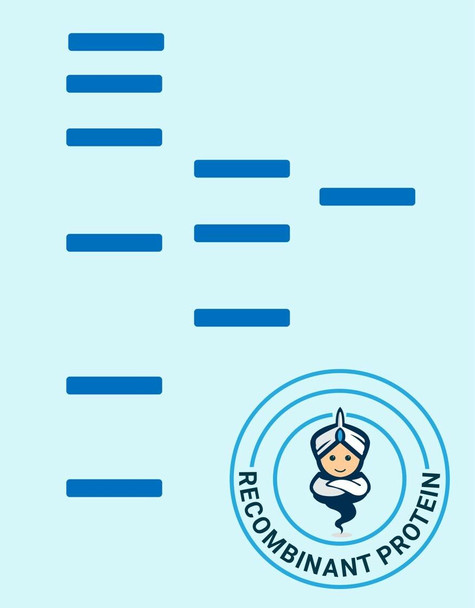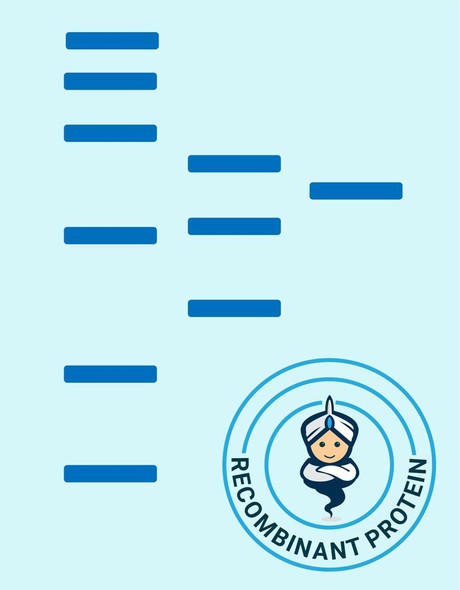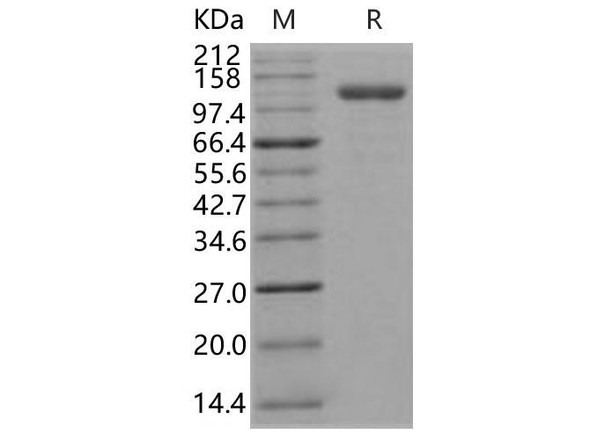Description
| Product Name: | Mouse Endoglin (27-581) Recombinant Protein |
| Product Code: | RPPB0181 |
| Size: | 5µg |
| Species: | Mouse |
| Target: | Endoglin (27-581) |
| Synonyms: | Endoglin, Cell surface MJ7/18 antigen, CD105, Eng, Edg. |
| Source: | Sf9 Insect cells |
| Physical Appearance: | Sterile Filtered colorless solution. |
| Formulation: | Endoglin protein solution (0.5mg/ml) containing Phosphate Buffered Saline (pH 7.4) and 10% glycerol. |
| Stability: | Store at 4°C if entire vial will be used within 2-4 weeks. Store, frozen at -20°C for longer periods of time.� For long term storage it is recommended to add a carrier protein (0.1% HSA or BSA).� Avoid multiple freeze-thaw cycles. |
| Purity: | Greater than 95.0% as determined by SDS-PAGE. |
| Amino Acid Sequence: | ERVGCDLQPV DPTRGEVTFT TSQVSEGCVA QAANAVREVH VLFLDFPGML SHLELTLQAS KQNGTETQEV FLVLVSNKNV FVKFQAPEIP LHLAYDSSLV IFQGQPRVNI TVLPSLTSRK QILDWAATKG AITSIAALDD PQSIVLQLGQ DPKAPFLCLP EAHKDMGATL EWQPRAQTPV QSCRLEGVSG HKEAYILRIL PGSEAGPRTV TVMMELSCTS GDAILILHGP PYVSWFIDIN HSMQILTTGE YSVKIFPGSK VKGVELPDTP QGLIAEARKL NASIVTSFVE LPLVSNVSLR ASSCGGVFQT TPAPVVTTPP KDTCSPVLLM SLIQPKCGNQ VMTLALNKKH VQTLQCTITG LTFWDSSCQA EDTDDHLVLS SAYSSCGMKV TAHVVSNEVI ISFPSGSPPL RKKVQCIDMD SLSFQLGLYL SPHFLQASNT IELGQQAFVQ VSVSPLTSEV TVQLDSCHLD LGPEGDMVEL IQSRTAKGSC VTLLSPSPEG DPRFSFLLRV YMVPTPTAGT LSCNLALRPS TLSQEVYKTV SMRLNIVSPD LSGKGLEHHH HHH |
Endoglin is a type I membrane glycoprotein located on cell surfaces and is part of the TGF beta receptor complex.The Endoglin protein consists of a homodimer of 180 kDA with disulfide links. Endoglin has been found on endothelial cells, activated macrophages, fibroblasts, and smooth muscle cells. Furthermore, Endoglin has been found to be part of the TGF-beta1 receptor complex. Endoglin thus may be involved in the binding of TGF-beta1, TGF-beta3, activin-A, BMP-2, and BMP-7. Beside TGF-beta signaling endoglin may have other functions. It has been postulated that endoglin is involved in the cytoskeletal organization affecting cell morphology and migration. Endoglin has a role in the development of the cardiovascular system and in vascular remodeling. Endoglin expression is regulated during heart development . Experimental mice without the endoglin gene die due to cardiovascular abnormalities.
Endoglin Mouse Recombinant produced in Sf9 Baculovirus cells is a single, glycosylated polypeptide chain containing 563 amino acids (27-581 a.a.) and having a molecular mass of 60.9kDa (Migrates at 50-70kDa on SDS-PAGE under reducing conditions).Endoglin is expressed with an 8 amino acid His tag at C-Terminus and purified by proprietary chromatographic techniques.
| UniProt Protein Function: | ENG: Major glycoprotein of vascular endothelium. May play a critical role in the binding of endothelial cells to integrins and/or other RGD receptors. Homodimer that forms an heteromeric complex with the signaling receptors for transforming growth factor-beta: TGFBR1 and/or TGFBR2. It is able to bind TGF-beta 1, and 3 efficiently and TGF-beta 2 less efficiently. Interacts with TCTEX1D4. Interacts with ARRB2. Endoglin is restricted to endothelial cells in all tissues except bone marrow. 2 isoforms of the human protein are produced by alternative splicing. |
| UniProt Protein Details: | Protein type:Membrane protein, integral; Motility/polarity/chemotaxis; Receptor, misc. Chromosomal Location of Human Ortholog: 2 B|2 22.09 cM Cellular Component: cell surface; cytoplasm; external side of plasma membrane; extracellular space; focal adhesion; nucleoplasm; receptor complex Molecular Function:galactose binding; glycosaminoglycan binding; protein binding; protein homodimerization activity; punt binding; transforming growth factor beta binding; transforming growth factor beta receptor, cytoplasmic mediator activity Biological Process: angiogenesis; artery morphogenesis; atrial cardiac muscle morphogenesis; central nervous system vasculogenesis; chronological cell aging; heart development; heart looping; negative regulation of cell migration; negative regulation of protein amino acid autophosphorylation; patterning of blood vessels; positive regulation of angiogenesis; positive regulation of BMP signaling pathway; positive regulation of collagen biosynthetic process; positive regulation of protein amino acid phosphorylation; positive regulation of transcription from RNA polymerase II promoter; regulation of transcription, DNA-dependent; regulation of transforming growth factor beta receptor signaling pathway; smooth muscle development; sprouting angiogenesis; transforming growth factor beta receptor signaling pathway; vasculogenesis; venous blood vessel morphogenesis |
| UniProt Code: | Q63961 |
| NCBI GenInfo Identifier: | 341940479 |
| NCBI Gene ID: | 13805 |
| NCBI Accession: | Q63961.2 |
| UniProt Secondary Accession: | Q63961,Q61520, Q8K100, |
| UniProt Related Accession: | Q63961 |
| Molecular Weight: | 70,021 Da |
| NCBI Full Name: | Endoglin |
| NCBI Synonym Full Names: | endoglin |
| NCBI Official Symbol: | Eng�� |
| NCBI Official Synonym Symbols: | Endo; CD105; AI528660; AI662476; S-endoglin�� |
| NCBI Protein Information: | endoglin |
| UniProt Protein Name: | Endoglin |
| UniProt Synonym Protein Names: | Cell surface MJ7/18 antigen; CD_antigen: CD105 |
| UniProt Gene Name: | Eng�� |








